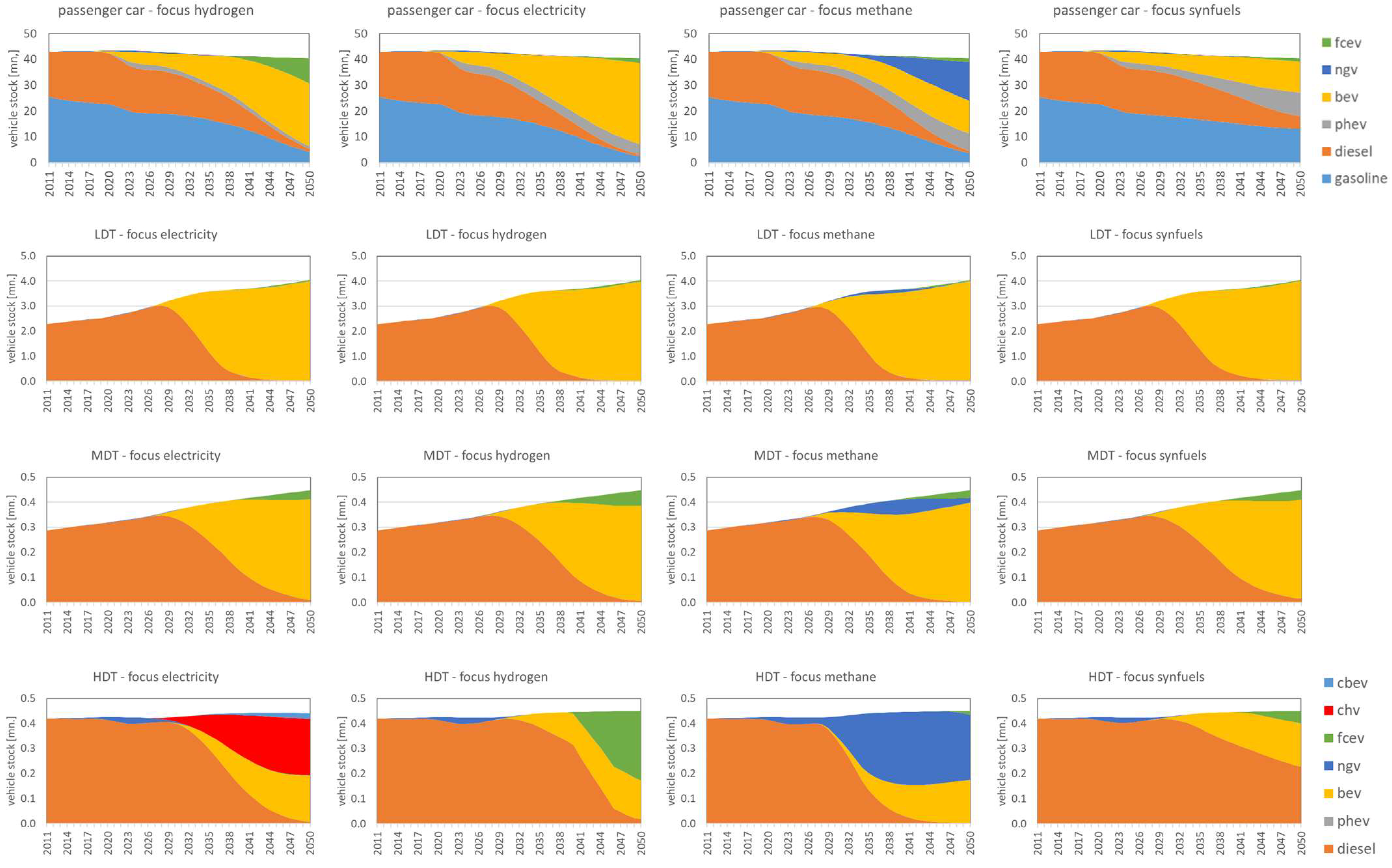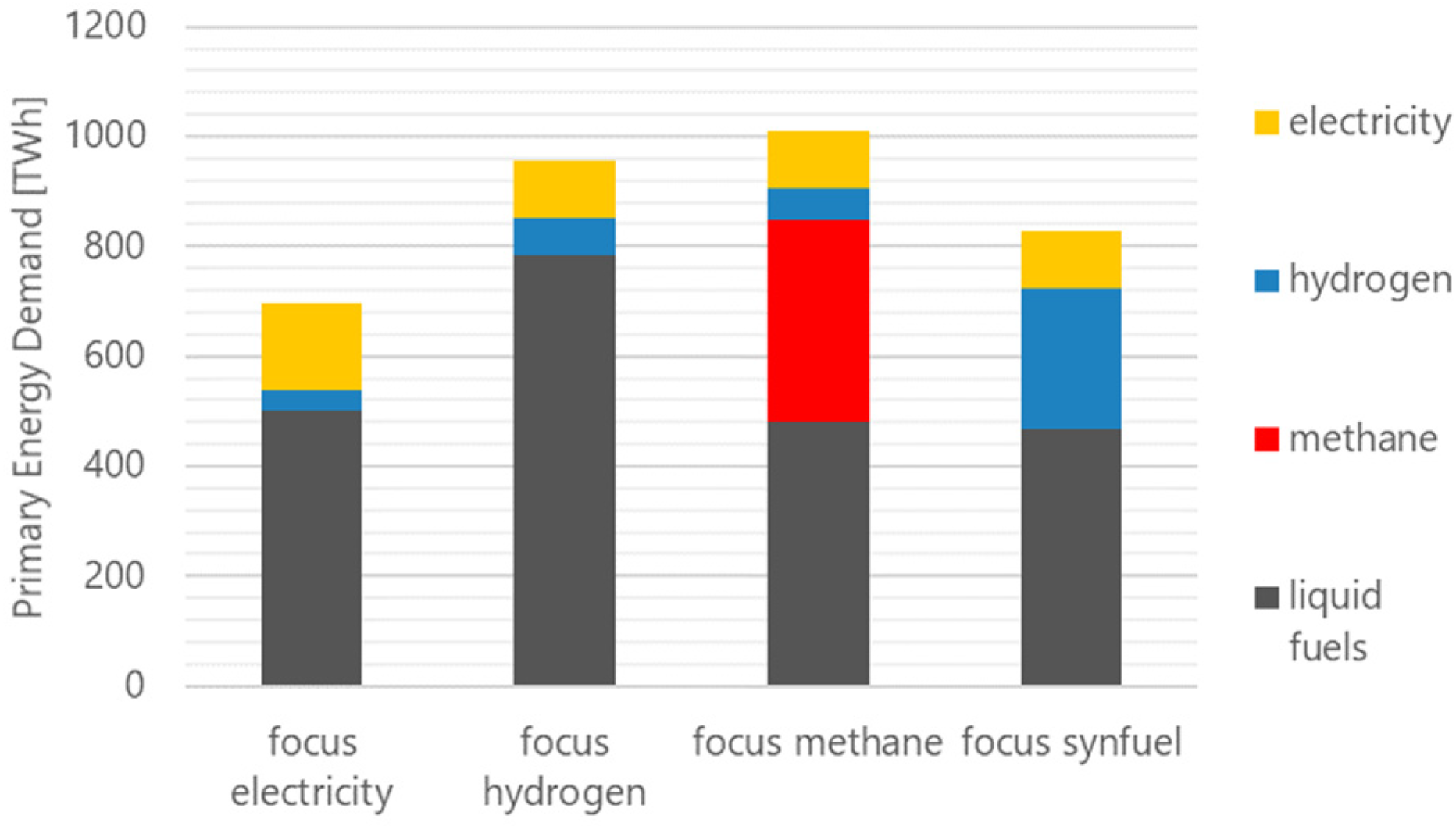Pathways to Carbon-Free Transport in Germany until 2050
Abstract
:1. Motivation
2. Methods and Data
| Scenario | EV Type | 2020 | 2030 | 2040 | 2050 |
|---|---|---|---|---|---|
| Focus—electricity | BEV | 240 | 100 | 90 | 80 |
| PHEV | 264 | 110 | 98 | 88 | |
| Focus—hydrogen | BEV | 240 | 100 | 100 | 100 |
| PHEV | 264 | 120 | 120 | 120 | |
| Focus—methane | BEV | 240 | 120 | 120 | 120 |
| PHEV | 264 | 132 | 132 | 132 | |
| Focus—synfuels | BEV | 240 | 120 | 120 | 120 |
| PHEV | 264 | 132 | 132 | 132 |
3. Results
4. Discussion and Conclusions
Author Contributions
Funding
Institutional Review Board Statement
Informed Consent Statement
Conflicts of Interest
References
- Plötz, P.; Axsen, J.; Funke, S.A.; Gnann, T. Designing car bans for sustainable transportation. Nat. Sustain. 2019, 2, 534–536. [Google Scholar] [CrossRef]
- German Federal Ministry of Justice. Federal Climate Change Act. 2021. Available online: https://www.gesetze-im-internet.de/englisch_ksg/englisch_ksg.html (accessed on 21 July 2022).
- German Environment Agency (UBA): Development and Goal Achievement of Greenhouse Gas Emissions in Germany in the Transport Sector According to Federal Climate Change Act. 2022. Available online: https://www.umweltbundesamt.de/bild/entwicklung-der-treibhausgasemissionen-des-verkehrs (accessed on 21 July 2022).
- SPD. Bündnis 90/Die Grünen; FDP: Mehr Fortschritt wagen. Bündnis für Freiheit, Gerechtigkeit und Nachhaltigkeit. In Koalitionsvertrag 2021–2025 zwischen SPD, Bündnis 90/Die Grünen und FDP; Coalition Agreement: Berlin, Germany, 2021. [Google Scholar]
- Blanck, R.; Kasten, P.; Hacker, F.; Mottschall, M. UBA: Treibhausgasneutraler Verkehr 2050: Ein Szenario zur zunehmenden Elektrifizierung und dem Einsatz stromerzeugter Kraftstoffe im Verkehr. In Abschlussbericht im Auftrag des Umweltbundesamtes zum Forschungsvorhaben Verkehr 2050—Entwicklung von Parametern und Skizzierung eines Vereinfachten Energie und Emissionsszenarios; Öko-Institut e.V: Berlin, Germany, 2013. [Google Scholar]
- Schmied, M.; Wüthrich, P.; Zah, R.; Althaus, H.-J.; Friedl, C. UBA: Postfossile Energieversorgungsoptionen für einen treibhausgasneutralen Verkehr im Jahr 2050: Eine verkehrsträgerübergreifende Bewertung. In Texte 30/2015, Studie im Auftrag des Bundesministeriums für Umwelt, Naturschutz, Bau und Reaktorsicherheit (UBA), Durchgeführt von INFRAS AG und Quantis; Umweltbundesamt: Dessau, Germany, 2015. [Google Scholar]
- Krail, M.; Speth, D.; Gnann, T.; Wietchel, M. Langfristszenarien für die Transformation des Energiesystems in Deutschland. Treibhausgasneutrale Hauptszenarien Modul. Verk. 2021, 1, 1–43. [Google Scholar]
- Krail, M. System-Based Analysis of Income Distribution Impacts on Mobility Behaviour. Ph.D. Thesis, Universtity of Karlsruhe, Karlsruhe, Germany, 2009. [Google Scholar]
- Gnann, T.; Plötz, P.; Wietschel, M. Can public slow charging accelerate plug-in electric vehicle sales? A simulation of charging infrastructure usage and its impact on plug-in electric vehicle sales for Germany. Int. J. Sustain. Transp. 2019, 13, 528–542. [Google Scholar] [CrossRef]
- Wietschel, M.; Gnann, T.; Plötz, P.; Doll, C. Electric trolley trucks—A techno-economic assessment for Germany. World Electr. Veh. J. 2019, 10, 86. [Google Scholar] [CrossRef] [Green Version]
- MOP. Mobilitätspanel Deutschland 1994–2010. Projektbearbeitung Durch das Institut für Verkehrswesen der Universität Karlsruhe (TH), Karlsruhe, Germany. Verteilt Durch die Clearingstelle Verkehr des DLR-Instituts für Verkehrsforschung. Available online: www.clearingstelle-verkehr.de (accessed on 22 June 2011).
- BMVI 2020: Verkehr in Zahlen 2020/2021; Federal Ministry for Transport and Digital Infrastructure (BMVI); Zentrum für Luft-und Raumfahrt e.V. (DLR); Institut für Verkehrsforschung Deutsches Institut für Wirtschaftsforschung Berlin e.V. (DIW): Berlin, Germany, 2020.
- Fraunhofer ISI. REM2030 Driving Profiles Database V2015; Fraunhofer Institute of Systems and Innovation Research ISI: Karlsruhe, Germany, 2015. [Google Scholar]
- Gnann, T. Market Diffusion of Plug-in Electric Vehicles and Their Charging Infrastructure; Fraunhofer Verlag: Stuttgart, Germany, 2015. [Google Scholar]
- Truckscout24: Sales Website for Used Commercial Vehicles. 2016. Available online: http://www.truckscout24.de (accessed on 13 February 2017).
- KiD 2010: WVI, IVT, DLR, and KBA (2010). In Kraftfahrzeugverkehr in Deutschland 2010 (KiD2010); WVI Prof. Dr. Wermuth Verkehrsforschung und Infrastrukturplanung GmbH, Braunschweig, IVT Institut für Angewandte Verkehrs-und Tourismusforschung e.V., Heilbronn, DLR Deutsches Zentrum für Luft-und Raumfahrt—Institut für Verkehrsforschung, Berlin; KBA Kraftfahrt-Bundesamt: Flensburg, Germany, 2010.
- Lutsey, N. Cost Projection of State of the Art Lithium-Ion Batteries for Electric Vehicles Up to 2030. Energies 2017, 10, 1314. [Google Scholar] [CrossRef] [Green Version]
- Zapf, M.; Pengg, H.; Bütler, T.; Bach, C.; Weindl, C. Kosteneffiziente und Nachhaltige Automobile; Springer Fachmedien Wiesbaden: Wiesbaden, Germany, 2019. [Google Scholar]
- Hülsmann, F.; Mottschall, M.; Hacker, F.; Kasten, P. Konventionelle und Alternative Fahrzeugtechnologien bei Pkw und Schweren Nutzfahrzeugen—Potenziale zur Minderung des Energieverbrauchs bis 2050; Working Paper; Öko-Institut: Berlin, Germany, 2014. [Google Scholar]
- Mottschall, M.; Kasten, P.; Kühnel, S.; Minnich, L. Sensitivitäten zur Bewertung der Kosten Verschiedener Energieversorgungsoptionen des Verkehrs bis zum Jahr 2050—Abschlussbericht. Abschlussbericht; Im Auftrag des Umweltbundesamtes; Dessau-Roßlau: Öko-Institut: Berlin, Germany, 2019. [Google Scholar]
- Al-Alawi, B.M.; Bradley, T.H. Review of hybrid, plug-in hybrid, and electric vehicle market modeling Studies. Renew. Sustain. Energy Rev. 2013, 21, 190–203. [Google Scholar] [CrossRef]
- Jochem, P.; Gómez Vilchez, J.J.; Ensslen, A.; Schäuble, J.; Fichtner, W. Methods for forecasting the market penetration of electric drivetrains in the passenger car market. Transp. Rev. 2018, 38, 322–348. [Google Scholar] [CrossRef] [Green Version]
- Gnann, T.; Stephens, T.S.; Lin, Z.; Plötz, P.; Liu, C.; Brokate, J. What drives the market for plug-in electric vehicles?—A review of international PEV market diffusion models. Renew. Sustain. Energy Rev. 2018, 93, 158–164. [Google Scholar] [CrossRef]





| Mode of Transport | Final Energy Demand in Germany in 2019 (PJ) [12] | Modeling of Future Market Diffusion |
|---|---|---|
| Passenger cars | 1549 | Individual buying decision based on TCO, favoring and hampering factors and vehicle and infrastructure availability |
| Heavy-duty vehicles | 692 | Individual buying decision based on TCO and vehicle and infrastructure availability |
| Trains | 52 | Literature based assumptions on future development |
| Buses | 48 | |
| Inland navigation | 11 | |
| Overseas navigation | 57 | |
| Aviation | 435 |
| Energy Carrier Cost | 2020 | 2030 | 2040 | 2050 |
|---|---|---|---|---|
| Power-to-hydrogen | 0.285 | 0.220 | 0.150 | 0.120 |
| Power-to-gas | 0.300 | 0.195 | 0.160 | 0.122 |
| Power-to-liquid | 0.300 | 0.205 | 0.170 | 0.132 |
| Scenario | 2020 | 2030 | 2040 | 2050 |
|---|---|---|---|---|
| Focus—electricity | 0% | 10% | 20% | 50% |
| Focus—hydrogen | 0% | 10% | 20% | 50% |
| Focus—methane | 0% | 20% | 50% | 100% |
| Focus—synfuels | 0% | 20% | 50% | 100% |
| Energy Carrier Price | 2020 | 2030 | 2040 | 2050 |
|---|---|---|---|---|
| Gasoline price | 0.154 | 0.233 | 0.315 | 0.293 |
| Diesel prices 1 | 0.117 | 0.197 | 0.281 | 0.261 |
| Hydrigen price 2 | 0.285 | 0.285 | 0.282 | 0.235 |
| CNG price 3 | 0.088 | 0.190 | 0.273 | 0.257 |
| LNG price 3 | 0.097 | 0.212 | 0.317 | 0.304 |
| Electricity price households 4 | 0.329 | 0.321 | 0.313 | 0.311 |
| Electricity price commercial 4 | 0.226 | 0.217 | 0.210 | 0.208 |
| Electricity price industrial 4 | 0.130 | 0.131 | 0.136 | 0.135 |
Publisher’s Note: MDPI stays neutral with regard to jurisdictional claims in published maps and institutional affiliations. |
© 2022 by the authors. Licensee MDPI, Basel, Switzerland. This article is an open access article distributed under the terms and conditions of the Creative Commons Attribution (CC BY) license (https://creativecommons.org/licenses/by/4.0/).
Share and Cite
Gnann, T.; Speth, D.; Krail, M.; Wietschel, M.; Oberle, S. Pathways to Carbon-Free Transport in Germany until 2050. World Electr. Veh. J. 2022, 13, 136. https://doi.org/10.3390/wevj13080136
Gnann T, Speth D, Krail M, Wietschel M, Oberle S. Pathways to Carbon-Free Transport in Germany until 2050. World Electric Vehicle Journal. 2022; 13(8):136. https://doi.org/10.3390/wevj13080136
Chicago/Turabian StyleGnann, Till, Daniel Speth, Michael Krail, Martin Wietschel, and Stella Oberle. 2022. "Pathways to Carbon-Free Transport in Germany until 2050" World Electric Vehicle Journal 13, no. 8: 136. https://doi.org/10.3390/wevj13080136






